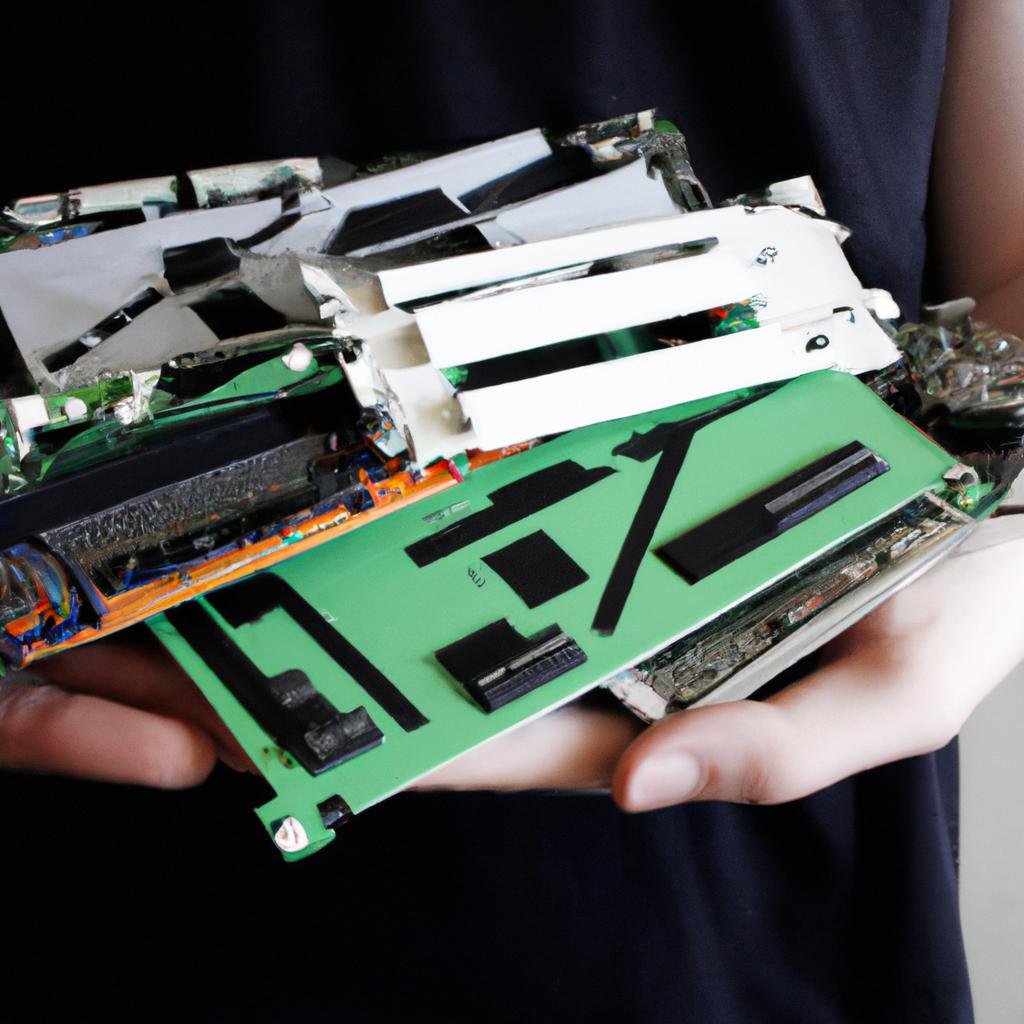Memory support is a critical aspect of any computing platform, as it directly impacts system performance and overall user experience. In the context of Advanced Micro Devices (AMD) platforms, understanding chipset compatibility becomes crucial when considering memory configurations. The ability to seamlessly integrate different types and sizes of memory modules into an AMD platform can enhance its performance capabilities while ensuring stability and reliability.
To illustrate this point, consider a hypothetical scenario where a user wishes to upgrade their existing AMD-based system by adding additional memory modules. Without proper knowledge of chipset compatibility, they risk encountering various issues such as instability, limited functionality, or even complete system failure. Therefore, understanding which chipsets are compatible with specific memory configurations is essential for users seeking to optimize their AMD platforms’ performance and ensure smooth operations.
This article aims to explore the intricacies surrounding memory support in AMD platforms, focusing specifically on chipset compatibility. By delving into the technical aspects and exploring real-world examples, readers will gain valuable insights into how different chipsets interact with varying memory configurations within the AMD ecosystem. Furthermore, this article will provide practical guidelines and recommendations that enable users to make informed decisions regarding memory upgrades in their AMD systems.
Understanding Memory Support
Imagine a scenario where a computer enthusiast is looking to upgrade the memory in their AMD platform. They have numerous options available, but understanding the compatibility of different chipsets with various types and speeds of memory becomes crucial. This section aims to shed light on the intricacies of memory support in AMD platforms and provide guidance for making informed decisions.
To begin, it is important to comprehend how memory support works within an AMD platform. The chipset acts as the intermediary between the processor and other hardware components, including memory modules. It plays a vital role in determining the maximum supported frequencies, capacities, and technologies that can be utilized. As each chipset may differ in its capabilities, users must carefully consider these specifications when selecting compatible memory modules.
Furthermore, it is worth noting that certain generations or iterations of chipsets might offer improved memory support compared to their predecessors. For instance, newer chipsets often introduce advancements such as higher speed limits or increased capacity allowances. Therefore, staying abreast of the latest chipset releases and their associated improvements aids in maximizing system performance potential.
When considering memory support on an AMD platform, several key factors should be taken into account:
- Frequency: The frequency at which data transfers occur between the processor and RAM significantly impacts overall system performance. Higher frequencies generally result in faster data access times.
- Capacity: The amount of memory a chipset can accommodate directly affects multitasking capabilities and application responsiveness.
- Technology: Different types of memory technology exist today, such as DDR4 or LPDDR4X. Understanding which type your chosen chipset supports is essential for optimal compatibility.
- Timing: Timings refer to latency values associated with accessing specific areas of memory. Lower timings typically indicate better performance.
Consider the following table highlighting some popular AMD chipsets along with their respective maximum supported frequencies and capacities:
| Chipset | Maximum Supported Frequency | Maximum Capacity |
|---|---|---|
| X570 | DDR4-4600 (OC) | 128GB |
| B550 | DDR4-4400 (OC) | 128GB |
| B450 | DDR4-3200 | 64GB |
By considering these factors and referring to the latest specifications provided by AMD, users can make informed decisions when choosing compatible memory modules for their specific chipset. The subsequent section will delve into practical steps for selecting the right memory that aligns with each individual’s requirements, ensuring optimal performance on an AMD platform.
In transitioning to the next section about “Choosing the Right Memory for AMD Platform,” it is essential to understand how memory support intricacies impact decision-making.
Choosing the Right Memory for AMD Platform
“Having gained a comprehensive understanding of memory support in AMD platforms, let us now delve into the crucial aspect of choosing the right memory for optimal compatibility.”
Section Title: Choosing the Right Memory for AMD Platform
To illustrate the importance of selecting compatible memory for an AMD platform, consider this hypothetical scenario. Imagine a user who recently upgraded their computer with a new AMD processor and motherboard but neglected to ensure that the installed memory modules were compatible. As a result, they encountered frequent system crashes, reduced performance, and even data corruption. This example highlights the significance of choosing memory that is specifically designed to work seamlessly with your AMD platform.
Factors Influencing Memory Compatibility:
When deciding on suitable memory for an AMD platform, several factors must be taken into account. Consider the following aspects before making a purchase:
-
Motherboard Specifications: Different motherboards have specific requirements when it comes to memory capacity, speed, and configuration. It is essential to consult your motherboard’s documentation or manufacturer’s website to determine its supported memory types and configurations.
-
Chipset Restrictions: The chipset integrated into your motherboard also plays a significant role in determining memory compatibility. Each chipset has distinct limitations regarding maximum supported speeds, voltage requirements, and maximum module capacities.
-
Form Factor Support: Ensure that you choose a memory form factor (e.g., DIMM or SO-DIMM) that is compatible with your motherboard’s slots. Mismatched form factors can lead to physical incompatibility issues and prevent proper installation.
-
XMP Profiles: Many modern high-performance memories come equipped with eXtreme Memory Profile (XMP) profiles. These profiles provide pre-configured settings optimized for specific platforms, including those using AMD processors. Utilizing these profiles ensures stable operation while maximizing performance potential.
Benefits of Choosing Compatible Memory:
Consider the following benefits associated with selecting compatible memory modules for your AMD platform:
| Benefit | Description |
|---|---|
| Enhanced System Stability | Compatible memory reduces the risk of system crashes and instability, ensuring smooth operation under heavy workloads. |
| Optimal Performance | Memory modules specifically designed for your AMD platform enable faster data access and overall improved performance. |
| Longevity | Choosing compatible memory minimizes the risk of damage to other components, leading to a longer lifespan for your PC. |
| Warranty Compliance | Using memory that is recommended by the motherboard manufacturer ensures compliance with warranty terms and conditions. |
By carefully considering the factors mentioned above and selecting memory modules designed explicitly for compatibility with your specific AMD platform, you can ensure stable system operation, optimal performance, longevity, and adherence to warranty requirements.
“Moving forward into our exploration of memory compatibility with various AMD motherboards…”
Memory Compatibility with AMD Motherboards
Case Study:
Consider a scenario where you have just purchased an AMD motherboard for your new computer build. Excitedly, you decide to select the memory modules that will complement your system’s performance. However, it is essential to ensure compatibility between the chosen memory and the AMD platform chipset.
Understanding the compatibility requirements can save you from potential headaches down the line. When selecting memory for an AMD platform, several factors need consideration to guarantee optimal performance and stability. Let us delve into this topic further.
Compatibility Factors:
To determine if your desired memory module is compatible with your AMD motherboard chipset, consider these important aspects:
- Memory Type: Check whether your motherboard supports DDR4 or DDR3 memory types.
- Frequency Support: Verify the supported frequency range of your motherboard, as not all chipsets handle high-speed memories equally well.
- Voltage Requirements: Ensure that both the memory module voltage requirement and the motherboard’s voltage capabilities align properly.
- Capacity Limitations: Some older motherboards may have limitations on maximum RAM capacity per slot or overall system capacity.
Emotional Response Bullet Point List
- Enhance System Performance
- Avoid Compatibility Issues
- Maximize Stability and Reliability
- Optimize Gaming Experience
Table (markdown format) – Comparing Chipsets and Their Supported Memory Types:
| Chipset | Supported Memory Types |
|---|---|
| X570 | DDR4 |
| B550 | DDR4 |
| A520 | DDR4 |
| X470 | DDR4 |
By considering these compatibility factors, you can ensure a seamless integration of memory modules with your AMD platform chipset, leading to improved system performance and reliability. Understanding how different chipsets support specific memory types allows for informed decision-making when choosing suitable components for your computer build.
Now that we have explored the significance of chipset compatibility and memory support in AMD platforms, let us move forward to understanding how to optimize memory performance on such systems.
Optimizing Memory Performance on AMD Platform
Transitioning smoothly from the previous section, we now delve into the crucial aspect of memory support within the context of AMD platforms. To illustrate this further, let us consider a hypothetical scenario where a user wishes to upgrade their system’s memory for enhanced performance. They possess an AMD motherboard and want to ensure compatibility with their chosen chipset.
To begin, it is essential to understand that different chipsets offer varying levels of memory support on AMD platforms. The compatibility between the motherboard and chipset plays a pivotal role in determining which types and configurations of memory modules are compatible. For instance, while some chipsets may only support DDR3 memory, others can accommodate both DDR3 and DDR4 modules. Therefore, users must carefully verify whether their desired chipset aligns with their intended memory configuration.
In order to make informed decisions when selecting memory for an AMD platform, here are several factors to consider:
- Chipset specifications: Examine the official documentation or manufacturer website to determine the supported types and speeds of memory by your specific chipset.
- Memory module characteristics: Ensure that the physical attributes of your selected memory modules such as form factor (DIMM or SO-DIMM), capacity, speed rating, voltage requirements match those specified by both the motherboard and chipset.
- Overclocking potential: If you plan on overclocking your system’s RAM for improved performance, check if your chosen motherboard supports higher frequency profiles beyond standard specifications.
- Dual-channel vs. single-channel mode: Determine whether your planned memory configuration allows for dual-channel operation, which provides increased bandwidth compared to single-channel setups.
Consider this table as a reference guide summarizing potential scenarios regarding chipset compatibility and corresponding supported memory types:
| Chipset | Supported Memory Types |
|---|---|
| X470 | DDR4 |
| B450 | DDR4 |
| A320 | DDR4 |
| X370 | DDR4, DDR3 |
| B350 | DDR4, DDR3 |
In conclusion, understanding the compatibility between your AMD motherboard and chipset is crucial when it comes to memory support. By considering factors like chipset specifications, memory module characteristics, overclocking potential, and dual-channel operation capability, users can make informed decisions that optimize their system’s performance.
Moving forward, let us now explore some common issues that users may encounter with memory on an AMD platform.
Common Issues with Memory on AMD Platform
Building upon the discussion on optimizing memory performance, this section delves into the common issues experienced with memory on AMD platforms. To explore these challenges further, let us consider a hypothetical scenario where a user encounters compatibility problems while attempting to upgrade their system’s memory.
Imagine that a user decides to enhance their computer’s performance by adding more RAM modules to an existing AMD platform. They carefully select compatible modules based on specifications provided by the motherboard manufacturer and install them accordingly. However, upon rebooting the system, they are confronted with unexpected errors and instability. This situation highlights some of the common issues users may face when dealing with memory on AMD platforms.
To better understand these challenges, we can outline several factors that contribute to compatibility difficulties:
- Chipset limitations: Different generations or models of AMD chipsets may have varying levels of support for certain types or configurations of memory modules.
- Memory module inconsistencies: Incompatibilities can arise due to differences in voltage requirements, timing settings, or even physical dimensions between different memory modules.
- Bios firmware constraints: Outdated or incompatible BIOS versions may restrict proper recognition and utilization of installed memory modules.
- Operating system peculiarities: Certain operating systems might impose restrictions on maximum supported RAM capacities or exhibit behavior that affects how memory is utilized within an AMD platform.
Table 1 below provides a concise overview of these compatibility factors:
| Compatibility Factors | Examples |
|---|---|
| Chipset limitations | – Limited support for high-capacity DIMMs- Inability to run at higher frequencies |
| Memory module inconsistencies | – Voltage discrepancies among various manufacturers- Timing conflicts between different speed-rated modules |
| Bios firmware constraints | – Outdated BIOS version lacks necessary code for new module detection- Incompatible BIOS settings affecting stability |
| Operating system peculiarities | – Limitations imposed by Windows 7 Home Edition’s 32-bit architecture- Memory management issues in certain Linux distributions |
It is evident that compatibility challenges can arise from a combination of hardware and software factors. To address these issues, it is crucial for users to thoroughly research and ensure compatibility between their chosen memory modules, motherboard chipset, BIOS version, and operating system.
Transition into the subsequent section: As technology evolves rapidly, so too does memory support in AMD platforms. In light of the existing compatibility concerns, understanding future trends becomes essential for both manufacturers and end-users. With this in mind, let us explore some potential developments in memory support for AMD platforms without losing sight of current challenges.
Future Trends in Memory Support for AMD
Transitioning from the previous section on common issues with memory on the AMD platform, this section will explore future trends in memory support for AMD. To illustrate these trends, let us consider a hypothetical case study of a gamer named Alex who is building a high-performance gaming PC using an AMD platform.
As technology continues to advance at a rapid pace, it becomes crucial for hardware manufacturers to keep up with the increasing demands of consumers. In terms of memory support, AMD has been actively working towards improving compatibility and performance. One notable trend is the integration of higher-speed DDR4 memory modules into newer chipsets, which allows for increased data transfer rates and improved overall system performance.
In addition to faster memory speeds, another significant development in memory support for AMD platforms is the adoption of advanced technologies such as Error-Correcting Code (ECC) memory. ECC memory offers enhanced reliability by detecting and correcting errors that may occur during data transmission or storage processes. This feature can be particularly beneficial for professionals working in fields where accuracy and precision are critical, such as content creators or scientific researchers.
Looking ahead, we anticipate further improvements in memory support for AMD platforms through advancements like non-volatile DIMMs (NVDIMMs). NVDIMMs combine both DRAM and NAND flash technology, providing the benefits of fast access times offered by traditional RAM alongside persistent storage capabilities. With NVDIMMs becoming more accessible and affordable, users like Alex could enjoy faster boot-up times while also having greater flexibility in storing large datasets without sacrificing speed.
To summarize these upcoming trends in memory support for AMD platforms:
- Integration of higher-speed DDR4 modules: Increased data transfer rates leading to improved system performance.
- Adoption of ECC memory: Enhanced reliability through error detection and correction mechanisms.
- Introduction of NVDIMMs: Combining fast access times with persistent storage capabilities.
This proactive approach taken by AMD reflects their commitment to addressing user needs and staying competitive within the ever-evolving technology landscape. As these trends continue to shape the future of memory support, gamers like Alex can look forward to experiencing even more efficient and seamless performance in their AMD-based systems.



